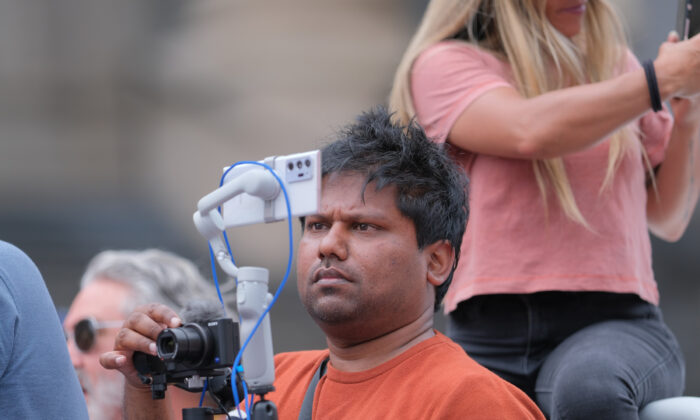
For Rukshan Fernando, something simply didn’t add up—it didn’t make sense.
News outlets portrayed the “government as doing great, the police are doing great, and that everything was great” in Victoria’s handling of the pandemic.
But at the same time, protesters were portrayed as fringe elements of society, “extremists” and “anti-vaxxers.”
“It didn’t gel with what I was feeling, as an individual,” Fernando told Pezou. “It didn’t gel with what friends and family around me were saying about their experiences during the time, and it certainly didn’t match some of the video footage that we were seeing captured on mobile phones.”
“I think that’s what really propelled me to take that step and to go out there—rather than just commentating on things—and actually go and film what’s happening on the ground.”
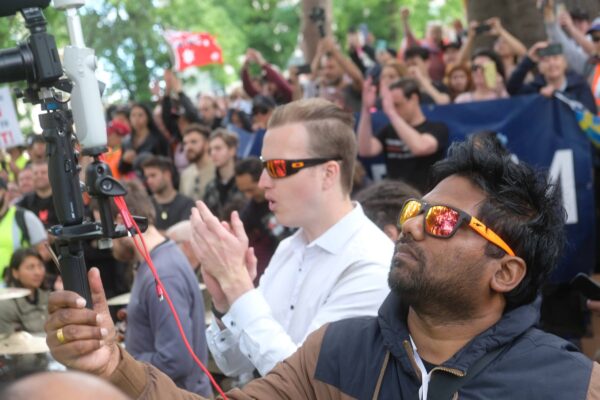
full-time wedding photographer’s approach was simple. Attend major events in Melbourne, set up a live feed from his camera, and shoot the proceedings—streaming hours of uninterrupted footage via his social media channels under the moniker “Real Rukshan.”
move has resonated.
In a few short months, Fernando, now a social media personality, has amassed over 400,000 followers across platforms such as Facebook, YouTube, and Instagram.
A recent live stream during Nov. 27 protests saw hundreds of Australians walk up to him, thank him for his work, and pose to take photos or selfies.
“Thanks for telling the truth, man,” one Melbournian said.
“You’re a legend!” another exclaims.
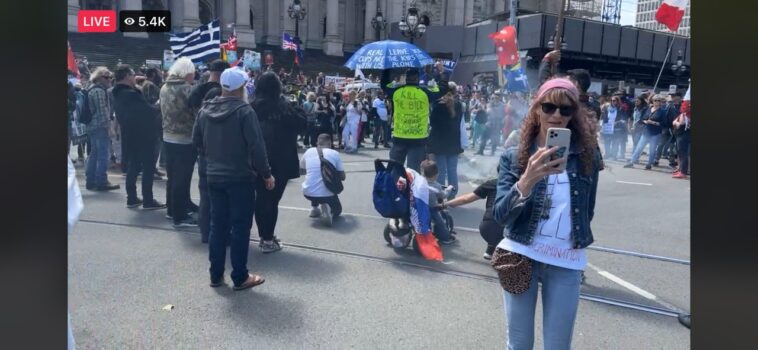
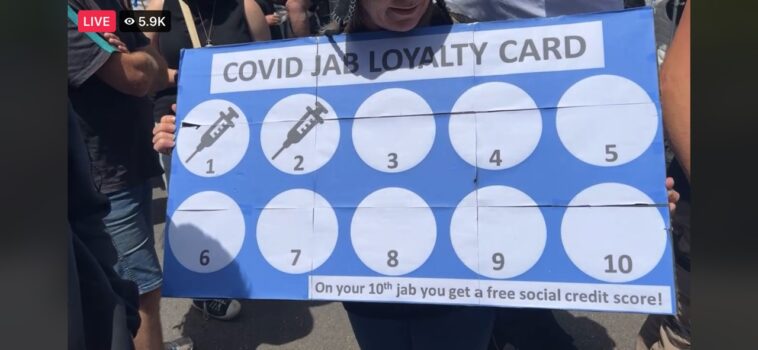
Confronting the COVID-19 Narrative
Fernando admits he is vigilant to avoid infringing on any rules.
He has received a visit from Victoria Police for his activities and attracted criticism for his appearance on Fox News after covering September protests, which saw police deploy tear gas and tough takedown tactics to apprehend rallygoers.
Josh Roose, a political sociologist at Deakin University, claimed Fernando’s activities were not passive and encouraged right-wing extremism.
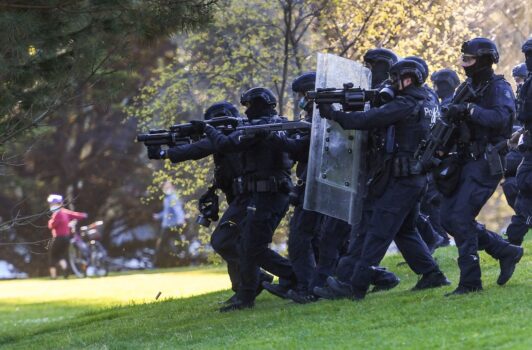
“[His videos have] grown him exponentially in the last week. It’s an interesting tactic and style. He’ll attend these protests, film the violence, yet deny responsibility,” he told the Sydney Morning Herald.
“His filming of the protest is actually part of the problem,” he added. “He films the spectacular … and seeks to bring in sympathy for protesters in the middle of a pandemic that not only are a health risk but have a record of being violent towards the police.”
weeks-long protest began when several members of the Construction, Forestry, Maritime, Mining, and Energy Union (CFMMEU) rallied outside the union headquarters over vaccine mandates in the construction industry.
protests turned ugly with incidents of violence. Soon after, the Victorian state government issued a sudden mandate to shut down all construction work in Melbourne for two weeks.
rallies escalated into a thousands strong march over several days around the city. Currently, protest activities continue on an almost-weekly basis, now drawing in people from all walks of life.
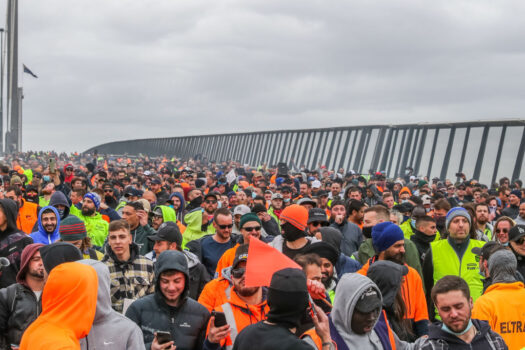
Yet, political leaders and media outlets have, for the most, downplayed or mischaracterised the actions.
Former Labor leader Bill Shorten called September protestors “man-baby Nazis,” while Western Australian Premier Mark McGowan told protesters in his state to “grow a brain.”
Fernando says on the ground he can see that frustrations are boiling over.
“People are angry overall with the government and the way they’ve been mistreated. Some people have lost their jobs, their livelihoods, and they’ve been outcast in society,” he said.
Pandemic Sparks Political Awakening
On Nov. 20, tens of thousands marched across the country in the most significant actions so far. It’s these numbers that are creating cracks in the government and media narrative, according to Fernando.
“It’s hard to ignore big numbers. I think as these numbers grow, these political leaders are having a very hard time saying this is an illegitimate thing. You can’t say 100,000 people are all extremist, you know?” he added, noting that many were fully vaccinated and that Australia’s high vaccination rate was not an “endorsement of government or government policy.”

activities have also lit a spark in him and many Australians, ushering in a renewed interest in politics—a sharp departure from what has been, for years, nothing more than a passing interest.
“I think what really happened with everything around the pandemic is, people starting to notice that actually there are individuals (political leaders and medical authorities) impacting their lives almost on a daily basis—making decisions about their jobs, their future, children, schools, whatever, and they’re seeing that process unfold in front of them,” he said.
“I think that’s kind of what’s happened here is people understand—finally—that it’s potentially important who’s in power, it’s important what bills are being passed, it’s also important what is the content of the bills.”
He is referring specifically to the Pandemic Management Bill, which has garnered widespread opposition from the legal community in Victoria over concerns it concentrates too much power in the hands of the state premier and health minister.
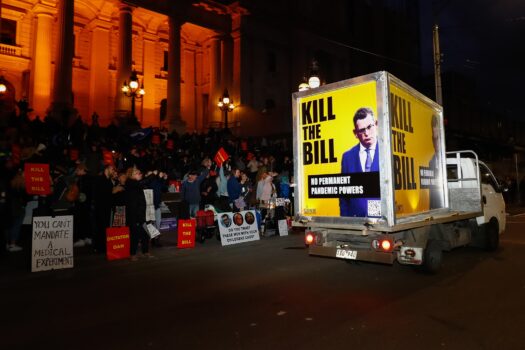
“I’ve noticed a lot more people really focused on the legislation itself and the actual content of the bill; they might not fully understand the legal terminology, but they’re willing to actually read it and be engaged with it.”
Seeing the Lockdowns Through a Different Lens
Australia has seen some of the lowest infection and death rates globally, which in turn has fostered a “safetyism-first” approach from many leaders, according to psychiatrist Tanveer Ahmed.
“I think as a country, we haven’t calculated the risks in a healthy way, and it’s been disproportionate,” he told Pezou. “We haven’t considered other important parts of life like sending our kids to school, for example.”
State leaders have also readily deployed tough measures to combat the virus, including domestic border closures, vaccine mandates, and snap lockdowns—sometimes across entire cities, even in response to a single case of COVID-19.
Alternative views, which challenge vaccine efficacy, lockdowns, and even the science behind COVID-19 have been met with scant tolerance.
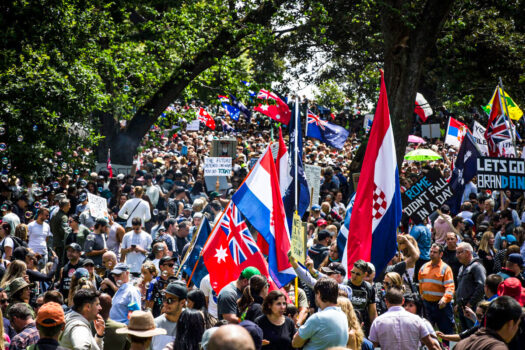
For example, Australian health authorities have suspended medical practitioners for sharing content on social media platforms that do not conform to existing medical orthodoxy around the COVID-19 disease.
“ government, the media and the authorities have all become like a three-headed snake—they’re all espousing the same views,” Fernando said.
“People are not happy about that in a sense, or it’s confirmed their suspicions of the media,” he added. “Alternative or independent media are filling that void in many ways.”
Fernando says protestors often tell him his live streams gave them a “different perspective” on the events happening in their city.
“It’s just to provide that balance. I don’t want to be this guy who’s like, ‘Hey, I’m showing you the one truth and exactly what I’m showing you on my live stream is exactly how it is.’ I understand there are different layers and different issues,” he said.
Ultimately, it is up to the individual to make up their own minds—whether that is watching commercial television, listening to the premier or the police, “People can take all of that in and come to their own conclusion.”
Pezou : Bringing Balance to Australia’s COVID-19 Story: ‘Real Rukshan’ on Lockdown Protests